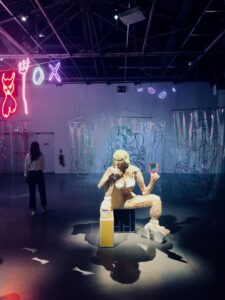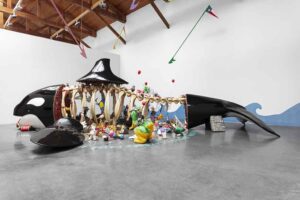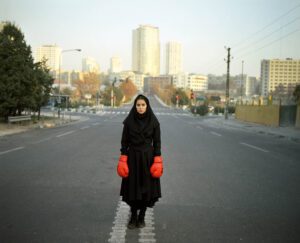
The majority of artists in the exhibition ‘City Prince/sses work out of Tehran, Mexico City, Manila, Lagos or Dhaka. Aside from a few exceptions, Western cultural capitals like Berlin, Paris, London or New York are only mentioned in passing. This is refreshing, since the geographic diversity of artists exhibiting in major contemporary institutions in Europe and across the Atlantic in the US is usually shockingly small. By shifting the art world boundaries further east and south, the curators Hugo Vitrani and Fabien Danesi significantly extend the scope and meaning of art today. The places of their choice are all megacities; they are too large to be ignored or cast aside as irrelevant to contemporary artistic production. Vitrani and Danesi illustrate how contemporary art is not just tied to technique, style, a school or ideological affiliation, but to the place it is made in. And within the Western art world context (with the exception of the Venice Biennale), these places are commonly overlooked and underrepresented. Vitrani and Danesi recognise this omission and respond to it by paving the way to an exhibition format that should be repeated again and again in the hopes of destabilizing our assumptions about what contemporary art looks like and most importantly, where it comes from.

The Palais de Tokyo is an enormous space, by typical art city standards and in Paris specifically, where real estate prices are among the highest in the world. With each new exhibition at the Palais de Tokyo, there is an immense potential in terms of what can be done with and to the space. It is also a daunting task that, in past exhibitions, has frequently turned into a labored effort to control the vast museum. City Prince/sses includes work by some 50+ artists. The curators in collaboration with scenographer Olivier Goethals position each artist and artist collective in a way that allows for a steady flow of the viewing experience: one installation transitions to the next and these spatial shifts feel seamless, as if we were moving through a utopian megacity that sprawls into all corners of the Palais de Tokyo.
With so many artists and this much real estate, not all curatorial choices are equally successful. One such example is the installation with father-son team Reza Shafahi+Mamali Shafahi. I am purposely using ‘installations with’ instead of ‘installations by’, because the artists’ work appears in competition with the curatorial vision (unless the artists explicitly asked for this type of overwrought hang). In this section of the exhibition, works on paper are arranged salon-style and mounted on a wall that looks like perforated drywall. The effect is a staggering amount of work in a relatively small space. In addition, each painting is framed by several Matisse-inspired cutouts that are made of the same perforated material as the wall they are arranged on. The result is a razzle-dazzle of textures and shapes that threaten to swallow Reza Shafahi’s exquisite paintings. Behind the wall of paintings we find an array of multi-media work by Mamali Shafahi in a dimly lit environment that blends sculptures, installations and screens into an anonymous, indistinguishable accumulation of ‘stuff’. It is a shame, because father and son offer a beautifully radical mix of wicked humor and civil disobedience by artistic means (both live and work in Tehran). They address questions of gender, sexuality, queer identity and patriarchy while also taking on and appropriating US popular culture in some of the video work by Mamali Shafahi.
But these occasional shortcomings of the exhibition are outweighed by work that deserves to be brought to the forefront. One such example and one of the show’s most powerful moments is Chelsea Culprit’s Transfigurations in Ritual Time from 2019. She is one of very few artists in the exhibition who is given an entire undivided room that delivers a streamlined viewing experience resembling a solo-show within the larger group show. Culprit works across various media that include one large mural, several neon-light installations, Picassoesque paintings of female nudes on shower curtains and four slightly larger-than-life sculptures of female strippers.
Her sculptures are engrossing and the materials she uses lend them a mildly repugnant appearance. We see humanoid creatures with melting skin who underwent a make-up tutorial gone wrong (the list of ingredients for these sculptures explains some of their effect: wood, cement, fiberglass resin, foam, steel, ceramic tile, paint and fabric). Much has been written about Nicole Eisenmann’s superb sculptures currently on display as part of the Whitney Biennale in New York City until September 22nd. Chelsea Culprit’s stripper twins are similarly textured, but infinitely more sinister. Culprit’s sculptures lack Eisenmann’s fantastical features which makes them particularly devastating and memorable objects.

A similarly unsettling work is Newsha Tavakolian’s six-channel video Listen from 2011. Tavakolian is a photographer who lives and works in Tehran and has been a Magnum Photo nominee since 2015. Her work is not defined by a single genre, even though she has been working as a photojournalist since 1999. Over the years, Tavakolian has covered a wide range of social and political issues, ranging from the 1999 protest movement of students in Iran, the US war on Iraq, to natural disasters and photo stories with a focus on women’s lives across the Middle East. For her video “Listen” she chose 6 professional Iranian female singers. Each is presented on her own screen in the process of singing while their voices cannot be heard. This is a political act of defiance, since the 1979 revolution instituted laws that forbid Iranian women from performing solo or recording their music. But Newsha Tavakolian’s work goes beyond a commentary on a ban. Each woman is filmed from her chest up and the camera’s proximity to their faces records their soundless performances as a mixture of protest and drowning. The video’s reference to Shirin Neshat’s 1998 Turbulant – a split-screen video installation about the audible performance of a male singer and the voiceless song of his female counterpart – cannot be overlooked. Neshat’s use of the internationally acclaimed Iranian-American singer Sussan Deyhim, and Tavakolian’s inclusion of contemporary Iranian singers who are forbidden from performing, points to a complicated relationship between (self-)exiled artists and artists who stay behind. Who is offering a more believable and relevant account? And is this even the right question to ask? It cannot be denied that there is much more at stake for Tavakolian’s subjects who reportedly had to be convinced over an extended period of time to participate in her video. This circumstantial distinction is what makes Neshat’s contribution a commentary, while Tavakolian risks an anti-authoritarian stance in the face of possible repercussions
There are more remarkable works in City Prince/sses that I can possibly write about here, so I am just going to name a few: Ashfika Rahman’s photographic series The Last Audience about a now defunct movie theater from her childhood neighborhood in Dhaka, Bangladesh; Falz’ video This is Nigeria which delivers a message on violence, abuse, and corruption among Nigeria’s political class while playfully referencing Childish Gambino’s 2018 song and video “This is America”; Ndidi Dike’s installation Untitled II is made up entirely of spent kerosene stoves; painter Manuel Solano who lost his sight due to an HIV-related infection and now paints portraits from memory; and lastly the many striking paintings presented by Lulu, an independent exhibition space in Mexico City that was founded by artist Martin Soto Climent and curator Chris Sharp.
City Prince/sses is imperfect. It’s both extroverted and introverted. It can be annoying, loud, quiet and even silent, but it does not disappoint and as a viewer you will come out more enlightened. First, you will realize that there is much more art out there than we as a Western audience are generally aware of and secondly, a great artist – as daring as this judgement might be – has interests and a stake outside of art. The exhibition encourages its audience to step out of a small art bubble and join the extended urban cosmos of City Prince/sses.
Viktor Witkowski
Volume 33 no 6 September – October 2019 pp 32-34
